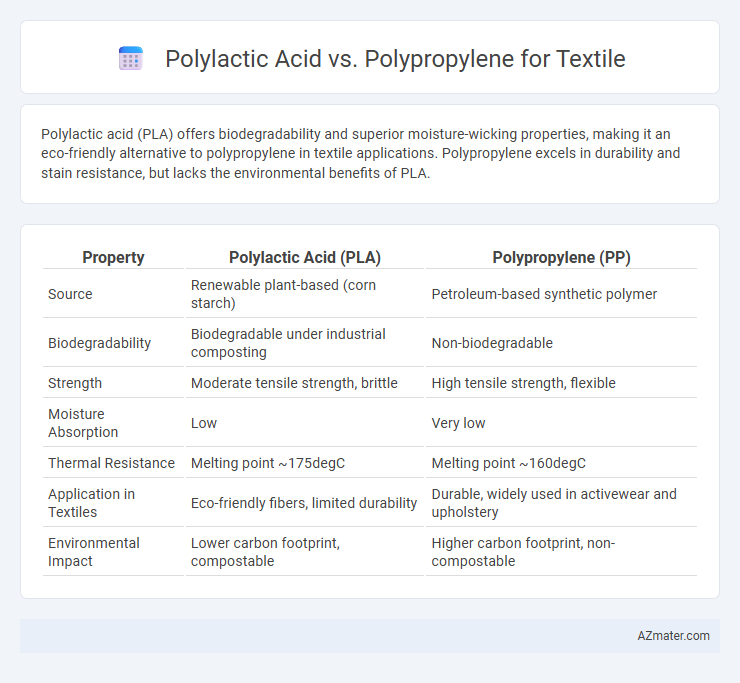Polylactic acid (PLA) offers biodegradability and superior moisture-wicking properties, making it an eco-friendly alternative to polypropylene in textile applications. Polypropylene excels in durability and stain resistance, but lacks the environmental benefits of PLA.
Table of Comparison
| Property | Polylactic Acid (PLA) | Polypropylene (PP) |
|---|---|---|
| Source | Renewable plant-based (corn starch) | Petroleum-based synthetic polymer |
| Biodegradability | Biodegradable under industrial composting | Non-biodegradable |
| Strength | Moderate tensile strength, brittle | High tensile strength, flexible |
| Moisture Absorption | Low | Very low |
| Thermal Resistance | Melting point ~175degC | Melting point ~160degC |
| Application in Textiles | Eco-friendly fibers, limited durability | Durable, widely used in activewear and upholstery |
| Environmental Impact | Lower carbon footprint, compostable | Higher carbon footprint, non-compostable |
Introduction to Polylactic Acid (PLA) and Polypropylene (PP) in Textiles
Polylactic acid (PLA) is a biodegradable, bio-based polymer derived from renewable resources such as corn starch and sugarcane, gaining prominence in sustainable textile production for its eco-friendly attributes and compostability. Polypropylene (PP), a synthetic thermoplastic polymer made from petroleum, is widely used in textiles for its durability, moisture resistance, and lightweight properties, especially in technical and performance fabrics. Comparing PLA and PP in textiles highlights a trade-off between environmental sustainability with PLA and superior mechanical strength and moisture management offered by PP.
Chemical Structure and Composition: PLA vs PP
Polylactic acid (PLA) is a biodegradable polyester derived from renewable resources such as corn starch or sugarcane, characterized by its repeating lactic acid units forming ester linkages in its backbone. Polypropylene (PP) is a synthetic, non-polar, hydrocarbon-based polymer composed of propylene monomers with a simple structure of methyl groups attached to a saturated carbon chain. The chemical structure of PLA offers biodegradability and hydrophilicity due to the presence of ester groups, whereas PP's entirely hydrocarbon structure provides hydrophobicity, chemical resistance, and durability, influencing their performance and environmental impact in textile applications.
Environmental Impact and Biodegradability Comparison
Polylactic acid (PLA) offers significant environmental advantages over polypropylene (PP) due to its origin from renewable resources like corn starch and its ability to biodegrade under industrial composting conditions within 6 to 12 months. Polypropylene, derived from fossil fuels, is resistant to biodegradation and can persist in the environment for hundreds of years, contributing to plastic pollution in landfills and oceans. While PLA reduces carbon footprint and supports circular economy principles, its biodegradability is limited to specific composting environments, unlike the non-biodegradable nature of polypropylene textiles.
Mechanical Properties and Durability in Textile Applications
Polylactic acid (PLA) offers high tensile strength and stiffness but exhibits lower impact resistance and flexibility compared to polypropylene (PP), which provides excellent toughness and elongation suitable for dynamic textile applications. PLA's biodegradability presents an advantage for sustainability, yet its lower thermal stability and susceptibility to hydrolysis reduce its durability under harsh environmental conditions. Polypropylene's superior chemical resistance and moisture repellency enhance its durability, making it preferable for long-lasting textiles requiring robust mechanical performance.
Moisture Management and Breathability Differences
Polylactic acid (PLA) fibers exhibit superior moisture management compared to polypropylene (PP) due to their hydrophilic nature, which allows better absorption and quicker drying of sweat. PLA textiles enhance breathability by facilitating enhanced air permeability and moisture vapor transmission, promoting comfort during high-intensity activities. In contrast, polypropylene fibers have hydrophobic properties that repel water, resulting in lower moisture absorption and potentially trapping sweat, though they provide good quick-drying performance and durability.
Dyeability and Color Retention Capabilities
Polylactic acid (PLA) fibers exhibit superior dyeability compared to polypropylene (PP) due to their hydrophilic nature, allowing better absorption of reactive and acid dyes. PLA also demonstrates enhanced color retention capabilities, maintaining vibrancy after multiple wash cycles and exposure to sunlight, unlike polypropylene which tends to exhibit color fading and poor dye affinity. These properties make PLA a preferred choice for textile applications requiring vibrant and long-lasting color performance.
Cost Analysis: PLA vs Polypropylene for Textile Production
Polylactic acid (PLA) generally incurs higher production costs compared to polypropylene (PP) due to its reliance on renewable raw materials like corn starch and more complex fermentation processes. Polypropylene benefits from established petrochemical supply chains, resulting in lower material and processing expenses, making it more cost-effective for large-scale textile manufacturing. Despite higher initial costs, PLA offers potential savings in end-of-life processing and environmental compliance, influencing long-term cost considerations in sustainable textile production.
Common Uses in Textile Industry: PLA and PP
Polylactic acid (PLA) is widely used in the textile industry for eco-friendly and biodegradable fabrics, often found in activewear, upholstery, and disposable medical textiles due to its moisture-wicking and UV-resistant properties. Polypropylene (PP) is favored for technical textiles, including industrial filters, geotextiles, and nonwoven fabrics, thanks to its high chemical resistance, durability, and lightweight nature. Both materials serve distinct roles in textiles, with PLA emphasizing sustainability and PP excelling in performance and cost-efficiency.
Consumer Perception and Market Trends
Polylactic acid (PLA) is increasingly favored by eco-conscious consumers due to its biodegradability and renewable sourcing, contrasting with polypropylene's widespread use for durability and affordability in textiles. Market trends show a growing demand for sustainable fabrics, driving innovation and adoption of PLA in fashion and home textiles, although polypropylene remains dominant in performance and technical textile sectors. Consumer perception highlights PLA as a premium, environmentally friendly alternative, while polypropylene is viewed as a cost-effective solution with established industry reliability.
Future Prospects and Innovations in PLA and PP Textiles
Polylactic acid (PLA) textiles are gaining momentum due to their biodegradability and sustainability, with innovations like enhanced fiber strength and improved moisture-wicking properties driving future market growth. Polypropylene (PP) remains dominant in technical textiles due to its durability, chemical resistance, and cost-effectiveness, while research focuses on integrating nano-additives and smart textile functionalities to expand its application scope. Advances in PLA recycling technologies and bio-based PP production are pivotal in aligning both materials with circular economy goals, positioning them for significant innovation-driven growth in the textile industry.

Infographic: Polylactic acid vs Polypropylene for Textile
 azmater.com
azmater.com